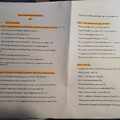Genetic engineering, also known as genetic modification or genetic manipulation, refers to the process of altering the genetic material of an organism by introducing or removing specific genes. It involves manipulating the DNA (deoxyribonucleic acid) of an organism to achieve desired traits or characteristics.
Purpose: there are various reasons: improve crops, develop medical treatments, conduct scientific research
Technique: recombinant DNA technology, gene editing tools
Applications: in agriculture: GM crops with traits like herbicide tolerance, pest resistance or improved nutritional content.
Benefits: increased crop yields, improved medical treatment, new therapies for genetic disorders
Concerns and ethical considerations: potential unintended consequenses on biodiversity, ecosystems and human health.
Cloning is a technique scientists use to make exact genetic copies of living things. Genes, cells, tissues, and even whole animals can all be cloned. Some clones already exist in nature. Single-celled organisms like bacteria make exact copies of themselves each time they reproduce.
Dolly (5 July 1996 – 14 February 2003) was a female Finn-Dorset sheep and the first mammal that was cloned from an adult somatic cell. She was cloned by associates of the Roslin Institute in Scotland, using the process of nuclear transfer from a cell taken from a mammary gland.
https://crisprtx.com/gene-editing/crispr-cas9
The pros of GMO crops are that they may contain more nutrients, are grown with fewer pesticides, and are usually cheaper than their non-GMO counterparts. The cons of GMO foods are that they may cause allergic reactions because of their altered DNA and they may increase antibiotic resistance.


